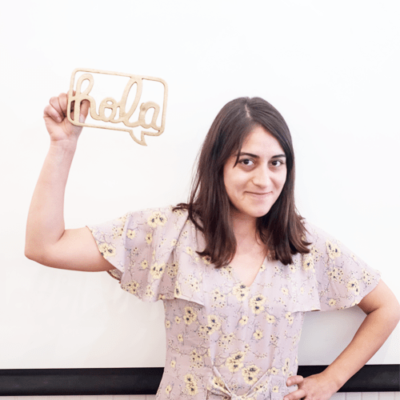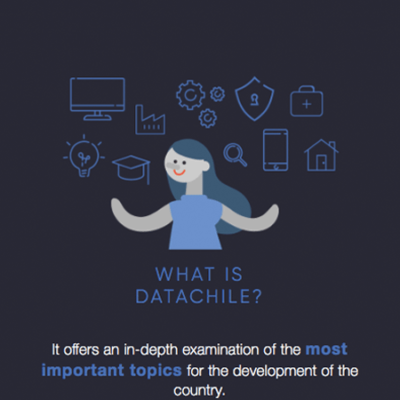My wish is that I will never lose the desire to learn new things and continue to
surround myself with people as brilliant as the people with whom I am currently
working with."
Graphic Designer Gabriela Perez Ponce represents a small but powerful company called Datawheel LLC. Ponce, along with a colorful team of programmers, mathematicians, designers, engineers, anthropologists, and physicists, work in unison building tools to aid governments and organizations in hands-on data platforms.
In other words, the company is formed by an enterprise of talent trained to execute the analysis and visualization of data-fueled decision making for institutions and other influential companies. Based in Boston yet branched in Valparaiso, Chile, Datawheel, “makes data easy to use and open to everyone by providing a costumed design with platforms oriented to facilitate exploration,” Ponce explains.
Ponce graduated from the Pontifical Catholic University of Valparaíso, in 2015 with a shiny new degree in graphic design. Joining Datawheel at the beginning of 2017 as a participant in the DataChile project, Ponce explains that a career in design had not always been the plan. “My beginnings were not precisely in design,” she says. “I started my studies in Computer Science— at eighteen years old I was very interested in computers and all the processes behind a program or game; I wanted to learn how to build things with them,” she says. Soon, however, Ponce had a change of heart.
“I realized that my interest was always the arts. Since I was a girl, I always enrolled in painting workshops [and] was always drawing or doing crafts at home or in my free time,” the designer tells us. But hesitations didn’t get in the artist’s way. “Now I understand that I got carried away by prejudices towards the profession as an artist and fears that are so common in Chile, such as: ‘Am I good at this? Will I have a job when I graduate?"’ Ponce admits. Shortly afterward, Ponce withdrew from computer science, but not with regrets. “I appreciate taking that path. I feel it was good to go through the first part to become what I am [today]. A person is built on experiences [and] whether they are good or bad, they are a part of you,” she says.
Ponce depicts DataChile as her biggest and best design piece thus far, stating: “I refer to [DataChile] as a great piece not thinking about the visual, but about the size and the content. I have never worked in the design of information from data visualizations [and] from that perspective, it was a project that required analytical thinking, a lot of creation of proposals [as well as] a lot of teamwork with other professionals. Taking into account all this experience together, it has very special value,” she says. Analysis has always been an area of intrigue for the Graphic Designer, and this can be seen in Ponce’s personal style of design. “My approach has always led toward the digital area, design interaction, and my strong interest in the field of user-friendly and aesthetically pleasing graphic interface design,” she says. “I really like the area of user analysis, the tools or techniques available to the designer with which you can manage to interpret emotions, feelings, actions or get to know the users better,” Ponce adds.
What type of influences speaks to the artist most? "I believe that great influences come from the observation of several icons or historical figures from the world of design. I have many references in the different arts, but initially, I think that several [influences include] teachers or people present in my childhood. For example, in school my art and music teachers, as well as creative people within my family, all helped me to have a first look that forged my thinking about design as art today,” she says. In regard to current topics feeding into the designer’s work, Ponce says, “Lately, I′ve been very interested in the realm of analog and digital illustration, which I sometimes try to include in the work I do. [This] was the case with the DataChile platform, where we aimed to incorporate [illustration] as part of a data narrative.”
Ponce’s steps and creative process as a designer are simple. “I think they change a bit depending on the project, but I always try to apply the following: Observation, setting objectives and projections, modeling and schematics, prototyping, visual layer and finally, implementation and adjustments," she states. Tools of the trade to execute her detailed plan entail: "A lot of Adobe CC products and recently Sketch. I think my favorite to make prototypes of illustrations is [from] Adobe Illustrator, I feel more comfortable using it than other tools,” she says. In such a competitive field, it’s crucial to stay on top of the latest design trends. When asked how she stays informed on the latest movements, Ponce relies on, “several recognized design firms or authors through their social networks or their publications in online media. To name a few— IDEO.org, FastCompany, GoogleDesign, Nesta.uk, and UXCollective,” she explains.
Further, outside influence over one’s aesthetic process is prominent in an artist’s approach to design. For Ponce, “I incline towards the minimalist, the simple over the complex. I do not like designs laden with unnecessary elements or just decoration. I think my influence on this point comes from minimalist art, I also like the impressionist tendency in terms of technique and color," she says. Brands that have a strong influence over Ponce include, "IDEO—I like IDEO very much; it has human-centered design kits and methodologies or tools that help in the design process,” Ponce says. In addition, “some of the books published by Tim Brown talk about Design Thinking or how to transform and inspire organizations through innovation and design. In general, I try to read from lesser-known authors or designers, who publish their ideas in their accounts on Medium. There is always something new to learn or something interesting to adopt from the many different perspectives of those toward design,” the artist says.
Where can we expect to see more from Ponce in the future? In terms of personal or professional goals, Ponce professes: “My wish is that I will never lose the desire to learn new things and continue to surround myself with people as brilliant as the people with whom I am currently working with. I feel fortunate to be part of this diverse group [DesignChile], and professionally, I would like to learn more things related to the development of product design— maybe study programming or computer science with a focus on the interaction in design,” she says. The best strains of advice Ponce employs— “Do not limit yourself”; “Always learn from your environment”; and a personal favorite: “Try it, even if you feel silly failing or not immediately achieving what you want,” she says.
Lastly, it’s not all labor and no play. When the young talent isn’t hard at work, several passions enthuse the creator. In terms of nature and exercise: “I like to practice yoga and go cycling through empty streets, to feel the wind in my face, [I] even try exercising at home. I enjoy walking in simple places close to nature,” she says. As for art and leisure: “I like to photograph situations and objects— things that catch my attention. [Also] read books, watch mystery or suspense series, listen to old music bands and new sounds as well. I also enjoy collecting things like postcards of places or objects that have cats, because I love them,” Ponce says.
Submit your work for Indigo Design Award competition





